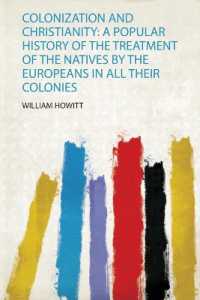基本説明
The sixteen chapters that make up this volume offer not only detailed studies of the situated use of metaphor in language, gesture, and visuals around the world but also careful explication and discussion of the methodological issues that arise when researchers approach metaphor in diverse 'real world' contexts.
Full Description
Metaphor is a fascinating phenomenon, but it is also complex and multi-faceted, varying in how it is manifested in different modes of expression, languages, cultures, or time-scales. How then can we reliably identify metaphors in different contexts? How does the language or culture of speakers and hearers affect the way metaphors are produced or interpreted? Are the methods employed to explore metaphors in one context applicable in others? The sixteen chapters that make up this volume offer not only detailed studies of the situated use of metaphor in language, gesture, and visuals around the world - providing important insights into the different factors that produce variation - but also careful explication and discussion of the methodological issues that arise when researchers approach metaphor in diverse 'real world' contexts. The book constitutes an important contribution to applied metaphor studies, and will prove an invaluable resource for the novice and experienced metaphor researcher alike.
Contents
1. List of contributors; 2. Acknowledgements; 3. Introduction: Metaphor in use (by MacArthur, Fiona); 4. Part 1. Contexts of research; 5. Chapter 1. An assessment of metaphor retrieval methods (by Berber Sardinha, Tony); 6. Chapter 2. Metaphor in discourse: Beyond the boundaries of MIP (by Kaal, Anna); 7. Chapter 3. Metaphor identification in Dutch discourse (by Pasma, Trijntje); 8. Chapter 4. Locating metaphor candidates in specialized corpora using raw frequency and keyword lists (by Philip, Gill); 9. Part 2. Contexts of production; 10. Chapter 5. Metaphor variation across L1 and L2 speakers of English: Do differences at the level of linguistic metaphor matter? (by Johansson Falck, Marlene); 11. Chapter 6. Metaphorical expressions in L2 production: The importance of the text topic in corpus research (by Golden, Anne); 12. Chapter 7. Researching linguistic metaphor in native, non-native and expert writing (by Chapeton-Castro, Claudia Marcela); 13. Part 3. Contexts of interpretation; 14. Chapter 8. Appreciation and interpretation of visual metaphors in advertising across three European countries (by Mulken, Margot van); 15. Chapter 9. English native speakers' interpretations of culture-bound Japanese figurative expressions (by Azuma, Masumi); 16. Chapter 10. The limits of comprehension in cross-cultural metaphor: Networking in drugs terminology (by Trim, Richard); 17. Part 4. Metaphor, topic, and discourse; 18. Chapter 11. Conceptual types of terminological metaphors in marine biology: An English-Spanish contrastive analysis from an experientialist perspective (by Urena Gomez-Moreno, Jose Manuel); 19. Chapter 12. Gestures, language, and what they reveal about thought: A music teacher's use of metaphor in Taiwan (by Chuang, Ya-Chin); 20. Part 5. Metaphor and culture; 21. Chapter 13. Armed with patience, suffering an emotion: The conceptualization of life, morality, and emotion in Turkish (by Aksan, Yesim); 22. Chapter 14. Trolls (by Alm-Arvius, Christina); 23. Chapter 15. A computational exploration of creative similes (by Veale, Tony); 24. Part 6. Afterword and prospects for future research; 25. Chapter 16. Metaphors, snowflakes, and termite nests: How nature creates such beautiful things (by Gibbs, Jr., Raymond W.); 26. Name index; 27. Terms index








